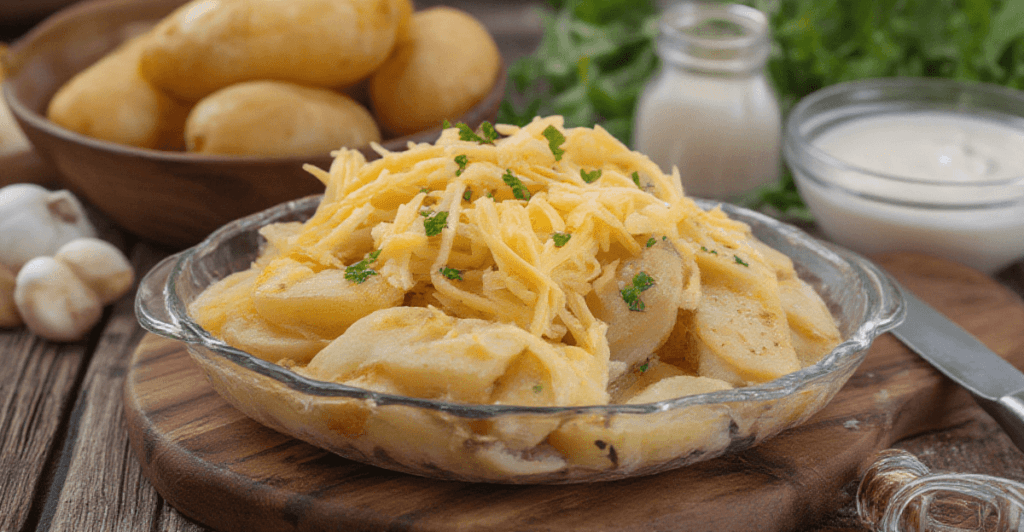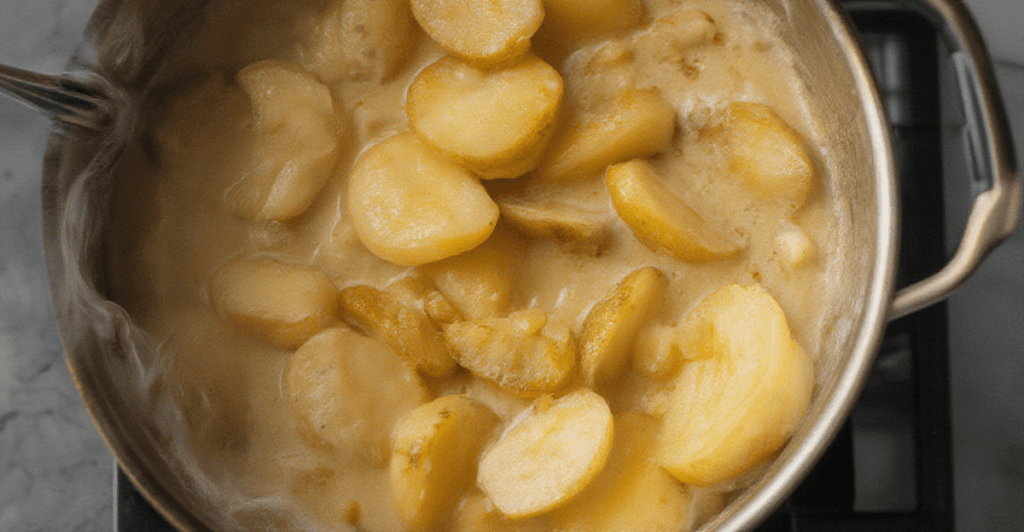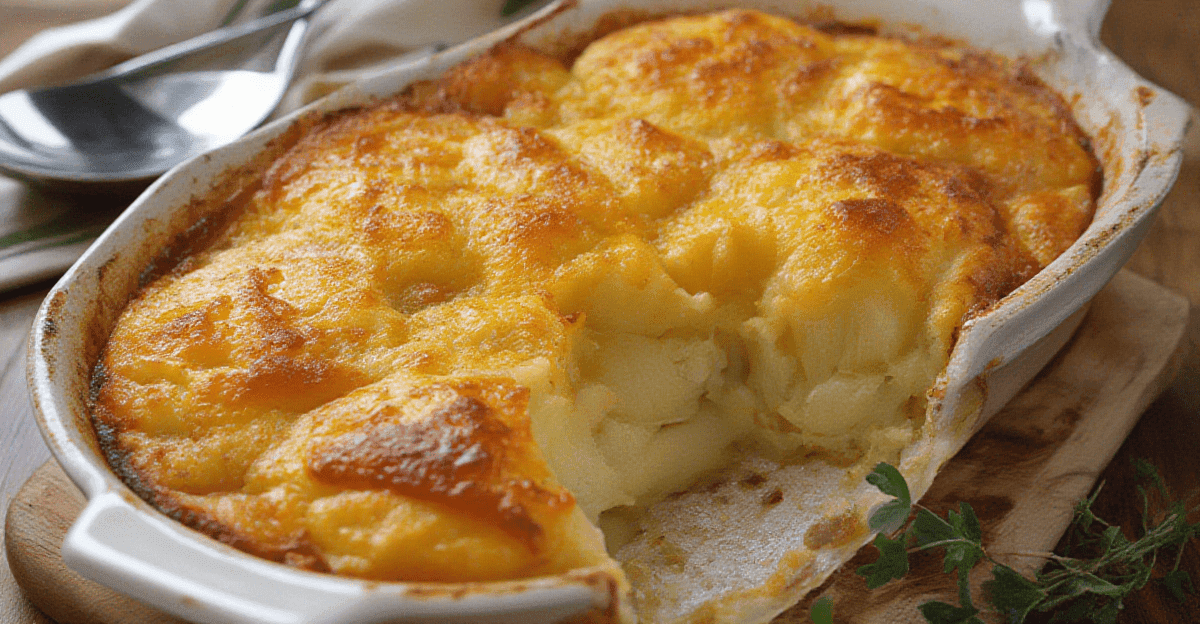Introduction
Scalloped potatoes are the ultimate comfort food—creamy, cheesy, and always a hit at family dinners or holiday gatherings. But let’s be honest, perfecting them can be tricky. Unevenly cooked potatoes, runny sauce, or bland flavors can spoil the dish. That’s where Michael Symon’s trick for scalloped potatoes comes to the rescue, ensuring delicious results every time.
That’s where Michael Symon, the award-winning chef and TV personality, comes in. Known for his creative spins on comfort food, Michael has a trick up his sleeve that guarantees perfect scalloped potatoes every time. The best part? It’s simple enough for anyone to try at home.
In this article, we’ll walk you through Michael Symon’s one simple trick, explain why it works so well, and show you how to recreate his method step by step. Plus, we’ll share extra tips to make your scalloped potatoes the star of any meal. Let’s get started!
Who is Michael Symon?
Overview of His Culinary Background
Before diving into the recipe, let’s take a moment to learn about the man behind the magic. Michael Symon is a celebrated chef, restaurateur, and television personality. Born in Cleveland, Ohio, he grew up with a love for hearty, homemade meals. His passion for cooking led him to culinary school, and from there, he quickly made a name for himself in the restaurant world.
Michael is best known for his appearances on Food Network shows like Iron Chef America and The Chew. His approachable style and love for bold, comforting flavors have earned him a loyal fan base. Whether he’s grilling burgers or perfecting classic dishes like scalloped potatoes, Michael knows how to bring out the best in every recipe.
His Influence on American Cuisine
Michael’s approach to cooking blends classic techniques with creative twists. He’s a big advocate of using fresh, high-quality ingredients to let natural flavors shine. His recipes often feel like an upgraded version of dishes you already love—making them perfect for home cooks who want impressive results without overcomplicating things.
Michael Symon’s trick for scalloped potatoes shows once again that even the simplest adjustments in his recipe can make a world of difference.
Scalloped Potatoes: A Classic Dish

Why Scalloped Potatoes Are So Popular
Scalloped potatoes have been a favorite comfort food for generations. They’re rich, creamy, and have that irresistible golden crust on top. Whether it’s a holiday feast, a potluck, or a cozy family dinner, this dish always finds a place on the table.
What makes scalloped potatoes so appealing is their balance of flavors and textures. The thinly sliced potatoes soak up the creamy sauce, while the cheese and breadcrumbs (if added) create a slightly crispy topping. Each bite is a mix of creamy, cheesy, and savory goodness.
Scalloped potatoes may seem simple, but achieving perfection requires a bit of expertise. This is where Michael Symon’s trick for scalloped potatoes comes in, addressing common challenges like undercooked potatoes, uneven layers, or runny sauces.
Traditional Ingredients and Techniques
The classic recipe for scalloped potatoes typically includes:
- Potatoes: Usually Yukon Gold or Russets because they cook evenly and absorb the creamy sauce well.
- Cream or Milk: This forms the base of the sauce and gives the dish its rich texture.
- Cheese: Often Gruyere, Cheddar, or Parmesan for that sharp, salty flavor.
- Garlic and Onions: These add depth and an aromatic touch.
- Seasonings: Simple salt, pepper, and sometimes nutmeg to enhance the flavors.
Traditionally, the potatoes are sliced thinly, layered with the cheese and cream mixture, and baked until tender. Sounds simple, right? But here’s the thing—small mistakes, like uneven slicing or not seasoning the potatoes properly, can affect the final result.
This is where Michael Symon’s secret trick comes into play.
The Secret to Perfect Scalloped Potatoes
Michael Symon’s Game-Changing Trick
So, what’s the one trick that Michael Symon swears by? He pre-cooks the potatoes in the cream mixture before layering them in the baking dish.
Yes, it’s that simple! Instead of layering raw potato slices straight into the dish and hoping they cook evenly in the oven, he simmers the slices in the cream mixture on the stovetop first.
Michael Symon’s trick for scalloped potatoes includes this crucial step, allowing the potatoes to absorb the flavors of the cream, cheese, and seasonings. It also ensures even cooking before they go into the oven, resulting in perfectly tender potatoes and a smooth, cohesive sauce.
Why Does This Trick Work So Well?
Let’s break it down:
- Even Cooking: When you pre-cook the potatoes, you eliminate the risk of some slices being undercooked while others are overdone.
- Enhanced Flavor: By simmering the potatoes in the cream, each slice absorbs the rich flavors of the cheese, garlic, and seasonings.
- Perfect Sauce Texture: Pre-cooking helps thicken the sauce slightly, so it stays creamy and coats the potatoes beautifully, without separating or becoming too runny.
This extra step doesn’t take much time but makes a world of difference in the final dish.
Step-by-Step Guide to Michael Symon’s Scalloped Potatoes
Ready to elevate your scalloped potatoes? Follow this detailed guide featuring Michael Symon’s trick for scalloped potatoes. It’s simple to follow, and the delicious results are well worth it. Let’s break it down step by step.
Essential Ingredients and Tools
Before you begin, gather everything you’ll need. Having everything ready will make the process smoother.
Ingredients:
- 2 pounds of Yukon Gold or Russet potatoes (thinly sliced)
- 2 cups of heavy cream
- 1 cup of milk
- 2 cups of shredded cheese (like Gruyere or Cheddar)
- 2 cloves of garlic (minced)
- 1 small onion (thinly sliced or diced)
- 1 teaspoon of salt
- ½ teaspoon of black pepper
- ¼ teaspoon of nutmeg (optional, for added warmth)
- 2 tablespoons of butter (for greasing the baking dish)
Tools:
- A sharp knife or mandoline for even potato slices
- A large saucepan or skillet
- A baking dish (9×13 inches works well)
- Aluminum foil
- Oven mitts or gloves
Preparation Process
Step 1: Preheat the Oven
Start by preheating your oven to 375°F (190°C). This ensures it’s hot and ready by the time you’ve prepared the potatoes.
Step 2: Slice the Potatoes
Using a sharp knife or mandoline, slice your potatoes into thin, even rounds (about ⅛ inch thick). Even slicing is key to ensuring they cook at the same rate.
Make the Cream Mixture
In a large saucepan or skillet, combine the heavy cream, milk, garlic, onion, salt, pepper, and nutmeg. Stir the mixture over medium heat until it’s warm and the flavors meld together.
Step 4: Pre-Cook the Potatoes
Here’s Michael Symon’s magic step! Add the potato slices to the warm cream mixture. Let them simmer gently for about 10 minutes, stirring occasionally to ensure they don’t stick to the pan.
Michael Symon’s trick for scalloped potatoes ensures the potatoes absorb the creamy flavors while their natural starch thickens the sauce. Be sure not to overcook them—just let them begin to soften.
Assembling the Dish
Step 5: Grease the Baking Dish
Use the butter to grease your baking dish. This prevents sticking and adds a bit of flavor to the edges.
Step 6: Layer the Potatoes
Using a slotted spoon, transfer half of the pre-cooked potato slices into the baking dish. Spread them out in an even layer. Sprinkle a generous amount of shredded cheese over this layer.
Michael Symon’s trick for scalloped potatoes involves layering the remaining potato slices on top, evenly pouring the cream mixture from the saucepan over the layers, and finishing with the rest of the cheese to create a golden, bubbly crust.
Step 7: Cover and Bake
Cover the dish with aluminum foil to prevent the top from browning too quickly. Place the dish in the preheated oven and bake for 30 minutes.
Step 8: Uncover and Finish Baking
After 30 minutes, carefully remove the foil and let the dish bake for another 20–25 minutes. This will allow the cheese on top to brown and form a crispy crust.
Serving and Presentation
Step 9: Let It Rest
Once your scalloped potatoes are out of the oven, resist the urge to dig in immediately! Let them rest for about 10 minutes. This allows the sauce to settle and thicken further, making it easier to serve.
Step 10: Serve and Enjoy
Use a large spoon to scoop out portions, ensuring each serving gets a good mix of the creamy layers and golden topping. Pair the scalloped potatoes with roasted meats, a fresh salad, or steamed vegetables for a complete meal.
Michael Symon’s trick for scalloped potatoes, combined with this step-by-step process, makes the recipe foolproof. The pre-cooking method ensures every bite is perfectly creamy, flavorful, and cooked to perfection.
Additional Tips from Michael Symon

Now that you’ve mastered the basic recipe, let’s dive into Michael Symon’s trick for scalloped potatoes, along with a few extra tips and ideas to make your dish even better. These simple tweaks can elevate your potatoes or help you customize them to your liking.
Pairing Scalloped Potatoes with Other Dishes
Scalloped potatoes are versatile and can be paired with many meals. Here are some suggestions:
- Roasted Meats: The creamy texture of the potatoes goes perfectly with roast chicken, beef, pork, or lamb.
- Seafood: A buttery baked salmon or grilled shrimp pairs well with scalloped potatoes for a balanced meal.
- Vegetarian Options: Pair the dish with roasted vegetables, a fresh green salad, or a hearty vegetable stew.
- Holiday Favorites: Scalloped potatoes shine on holiday tables alongside turkey, ham, or stuffing.
By pairing this dish thoughtfully, you can create a meal that feels complete and satisfying.
Storing and Reheating Leftovers
If you have leftovers (though they might disappear quickly!), you can store them for another meal.
How to Store:
- Let the scalloped potatoes cool completely.
- Transfer them to an airtight container or cover the baking dish tightly with plastic wrap.
- Refrigerate for up to 3 days.
How to Reheat:
- Preheat your oven to 350°F (175°C).
- Cover the dish with foil to keep the potatoes moist and heat for 15–20 minutes.
- For a crispy top, uncover during the last 5 minutes of reheating.
Michael Symon’s trick for scalloped potatoes includes avoiding reheating in the microwave, as it can cause the sauce to separate or make the potatoes soggy.
Creative Variations
Michael Symon encourages creativity in the kitchen, so don’t hesitate to put your spin on this classic dish. Here are some ideas:
- Add Veggies: Mix in thinly sliced mushrooms, spinach, or caramelized onions for added flavor.
- Try Different Cheeses: Experiment with cheeses like Fontina, Gouda, or Blue Cheese for a unique twist.
- Add Protein: Layer in cooked bacon, diced ham, or shredded chicken for a heartier dish.
- Spice It Up: Sprinkle in a pinch of cayenne pepper or smoked paprika for a little heat and smoky flavor.
- Make It Gluten-Free: Use cornstarch or arrowroot powder to thicken the sauce if you need to avoid flour.
Avoiding Common Mistakes
Even with the best recipe, small missteps can affect the outcome. Here’s how to avoid them:
- Slice Evenly: Use a mandoline if possible to ensure all potato slices are the same thickness. Uneven slices can lead to some parts cooking faster than others.
- Don’t Rush the Simmering Step: Pre-cooking the potatoes in the cream is essential for flavor and texture, so don’t skip or rush this step.
- Season Well: Potatoes can be bland if not seasoned properly. Taste the cream mixture and adjust salt and pepper as needed before baking.
- Watch the Baking Time: Covering the dish with foil at first ensures the potatoes cook through without burning the top layer. Removing the foil later allows the cheese to brown beautifully.
Michael Symon’s trick for scalloped potatoes offers expert advice to perfect the dish and makes it simple to adapt the recipe to your preferences.
FAQs
How Do You Use Cheese Seasoning Powder?
Cheese seasoning powder is a versatile ingredient that can enhance the flavor of scalloped potatoes and other dishes. Here’s how you can use it effectively:
- Mix Into the Sauce: Before pouring the cream mixture over the potatoes, whisk in a few teaspoons of cheese seasoning powder. This will boost the cheesy flavor without needing extra cheese.
- Sprinkle Between Layers: When layering the potato slices, sprinkle a small amount of cheese powder between each layer for even distribution.
- Top It Off: Mix the cheese powder with breadcrumbs or grated cheese and sprinkle it on top of the scalloped potatoes before baking. This creates a flavorful and crispy crust.
- Adjust to Taste: Cheese powder can be salty, so use it sparingly at first and adjust to your taste as you go.
This ingredient is a great shortcut for adding extra cheesy flavor when you don’t have fresh cheese on hand.
How Do You Make Paula Deen’s Scalloped Potatoes?
Paula Deen’s scalloped potato recipe is another beloved take on this classic dish. Here’s a simple summary of her method:
Ingredients You’ll Need:
- 6–8 medium-sized potatoes, peeled and thinly sliced
- 2 cups of heavy cream
- 2 cups of shredded Cheddar cheese
- ½ cup of Parmesan cheese
- 1 stick of butter (½ cup), melted
- Salt and pepper to taste
Steps to Make Paula Deen’s Scalloped Potatoes:
- Preheat the Oven: Heat to 350°F (175°C).
- Prepare the Dish: Grease a baking dish with butter.
- Layer the Potatoes: Add a layer of sliced potatoes to the dish. Sprinkle with salt, pepper, and a generous amount of shredded Cheddar cheese. Repeat the layers until all potatoes and cheese are used.
- Make the Sauce: Combine the heavy cream and melted butter. Pour this mixture evenly over the layered potatoes.
- Top with Parmesan: Sprinkle Parmesan cheese over the top layer for added richness.
- Bake: Cover with foil and bake for 45 minutes. Remove the foil and bake for an additional 20–30 minutes, or until the top is golden brown and bubbly.
This version is rich and indulgent, staying true to Paula Deen’s signature style of cooking.
What Is the Difference Between Scalloped Potatoes and Au Gratin Potatoes?
While scalloped potatoes and au gratin potatoes are similar, there are a few key differences that set them apart:
- Cheese:
- Scalloped potatoes traditionally do not include cheese in the recipe. Instead, they are made with a cream-based sauce and sometimes breadcrumbs on top.
- Au gratin potatoes, on the other hand, always include cheese, both in the layers and on top, for a richer and more indulgent dish.
- Slicing:
- Scalloped potatoes are typically sliced a bit thicker.
- Au gratin potatoes are usually sliced thinner for a more delicate texture.
- Topping:
- Scalloped potatoes might have breadcrumbs on top for a crispy crust.
- Au gratin potatoes rely on cheese to create that golden, bubbly crust.
- Flavor:
- Scalloped potatoes are simpler and rely on the flavors of cream, butter, and seasonings.
- Au gratin potatoes are cheesier and have a bolder flavor profile.
Both dishes are delicious, but if you’re a cheese lover, au gratin potatoes might be the better choice!
Conclusion
Scalloped potatoes are a timeless comfort food, and with Michael Symon’s expert tip, you can easily take this dish to the next level. By pre-cooking the potato slices in the creamy mixture, you ensure even cooking, enhanced flavor, and a perfectly thickened sauce. It’s a simple step that makes a big difference, whether you’re serving these at a holiday feast or a weeknight dinner.
We’ve also explored additional tips, creative variations, and common mistakes to avoid, so you’re fully equipped to make your scalloped potatoes the star of any meal. For those who want to try something different, options like Paula Deen’s rich and cheesy recipe or using cheese seasoning powder can add a unique twist. And now, you know the subtle differences between scalloped and au gratin potatoes, making it easier to choose the right dish for any occasion.

